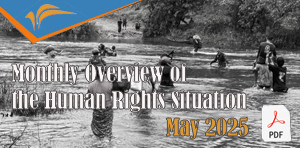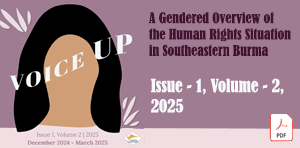Andin locals practice mangrove forest conservation
May 2, 2018
Local residents from Parlain village, Andin village track, Ye Township, Mon State, are developing a mangrove forest conservation project in order to protect their natural resources against megaprojects that are harmful to their environment and ecosystem. The majority of Parlain residents rely on the surrounding environment for their daily livelihood needs.
“The purpose of growing the mangrove forest is related to [mega]projects. At first, people were worried about coal projects, which have had huge [environmental] impacts, so the locals have opposed it. During their campaign against coal, they researched what were the main livelihoods of the locals. They realized that the locals heavily rely on natural resources for their livelihoods. That’s why they decided to grow mangrove forests to conserve their environment,” said Ma Ni Mar Oo, an environment activist from Andin village.
In 2014, the Toyo-Thai Co. Ltd. (TTCL) announced plans to develop a coal-fired power plant near Andin village. Locals have strongly opposed the project, and at the same time, increased their momentum on conservation of the surrounding environment, according to the Parlain Rehabilitation Experience Report released on April 25th 2018.
Parlain locals researched local livelihoods from 2014–2015 and found that plantations, paddy farming, and fisheries were the three main livelihoods in the region. The fishery industry accounts for the most income, generating three billion kyat (US $2,248,939) per year.
Data gathered for the report has encouraged locals to conserve mangrove forests as they support their livelihood activities.
“Mangrove forests prevent soil erosion from river banks. And it benefits paddy farmers because it stops sea water from flowing into paddy fields. It also provides protection against natural disasters and produces fresh air too,” said Mi Ni Mar Oo.
Moreover, these forests can provide locals with wood for construction of houses and boats, as well as firewood and charcoal for their daily usage. Local villagers also make fences with wood they get from mangrove forests.
According to locals, the government has not supported mangrove forest conservation and locals had to use their own financial and labor resources for the project. Therefore, the locals have sent an application to the Ye Township General Administration Department (GAD) asking that local authorities acknowledge that the mangrove forests in their region are owned by the local communities.
Even though the Ye Township Forestry Department and Department of Agriculture Land Management and Statistics has agreed with the locals, the Chief Administrator of the Ye Township GAD has refused to approve their request.
“The administrator complained that the place we’ve grown the mangrove forest is on military land. Even though the clerk of the Land Records Department explained that the mangrove forest isn’t related to the land given up by the military, the administrator won’t accept that. The [Mon State] Chief Minister has said approval from the GAD is essential in order to get official documentation [for the mangrove forest],” said Venerable Monk Ashin Nanda of the Andin Monastery.
The local residents, monks, the Forestry Department, and the Land Records Department will continue their fight to get official documentation for the community-owned mangrove forest, according to the Monk.
Locals estimate there are about 1,000 acres of mangrove forest in the region and that 49 species of mangrove tree have been added in 190 acres.
Comments
Got something to say?
You must be logged in to post a comment.



















































